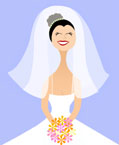 |
The
Flirty Bride Made exactly the way you want, especially for you! |
Veil FAQ's
Base - Beading - Blusher - Ceremony Only - Color - Edging - Length - Nylon or Silk - Placement
The different options of wire comb, elastic loops or Velcro are best consulted with your hair hairstylist. Depending on the type of hair style chosen they will almost always have a preference to the type of base being used. If you have already chosen a headpiece from another source a The Flirty Bride veil can be attached to your existing headpiece by shipping it to my design studio.
Is
there a big difference between a plastic comb and a wire comb?
Most
definitely! Ask most hairstylists and they will tell you there is a
huge difference between the two! The wire comb will always anchor into
the hair more securely and with less bulk. It can also be removed more
easily without messing up your hairdo. It can also be anchored into
place with additional bobby pins, something impossible to do with a
thick and slippery plastic comb.
Here is a quick run down of the base options:
Wire Comb: Ideal when placing the veil at the top of the head. Also suitable when worn at the back of the head below an updo
Elastic Loops: Perfect to place around any bun shaped updo as the elastic will allow your hairstylist to conform the veil to the shape of the updo.
Velcro: If you have an existing headpiece that has a Velcro attachment, simply send me the measurement of the Velcro and whether you have the hook or loop side and I would be happy to put your The Flirty Bride veil onto the opposing side of Velcro so that you can simply attach it to the headpiece.
Should I add beads to my veil?When advising brides I always offer suggestion based on the theory that less is more. If their gown already has beads on it, they probably don't need to add more to the veil. The sparkle will shine right through the tulle of the veil. Beads can always be added to the part of a floor length veil that extends beyond the train. Adding a fully beaded veil to a beaded gown looks best for very formal evening weddings.
Each individual bead is handsewn with invisible nylon thread. There is no visible thread or thread ends giving your veil a beautiful couture finish!
Why
pay more for hand-beading?:
Gluing beads to a veil most often leaves visible clumps
or globs of glue surrounding each bead. It will also leave drag marks
if beads slip and roll across the fabric before the glue has dried.
If you are sentimental and want to save your veil in the hopes it will
become a cherished family heirloom, handsewn beads withstand the cleaning
process better and hold up better in storage as glue yellows and darkens
over time.
Hand Beaded Floor Length Veils
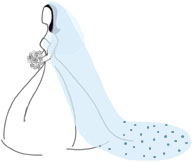 |
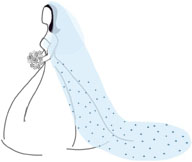 |
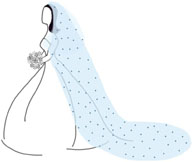 |
|
Floor only |
Waist down |
Top to bottom |
Many brides are now choosing not to wear a blusher as they take their big stroll down the aisle. That's o.k. so long as you aren't having a formal church wedding that frowns upon exposed shoulders. If this is the case then a blusher is subtle compromise that will at least cover your shoulders on the way down the aisle, if not on the way back up.
I also encourage all brides to have their photographer take at least one close-up of them with the blusher pulled forward. It makes for a beautifully romantic portrait...
Do
I have to wear a veil at my reception is one of the most often asked
questions I hear. You don't have to do anything, but keep in
mind that your photographer will be taking pictures throughout your
reception: the toast, the first dance, the bouquet toss, so you may
want to keep your veil on at least through the cake cutting.
Many
photographers over the years have told me they prefer the veil left
on during the reception as it gives the finished wedding album a nice
flow and continuity if you look the same from the first to final page.
Otherwise you may go from looking like the "Bride" at your
ceremony to looking like "the girl in the white dress" at
your reception.
Another
point in favor of keeping the veil on is that if your hair is pinned
up the veil softly frames your face and looks beautiful in pictures...
A well cut veil is very photogenic!
White is a beautiful bright white only used with synthetic fabrics. Silk is never this shade of bright white.
Shimmer White is the same bright shade of white described above but has a bright sheen that makes it sparkle.
Diamond White is the most popular shade of veils. A bit warmer then white but not as yellow as ivory. It is the color of white silk. Also known by the names candle lit white and silk white. I often have brides with ivory gowns order diamond white as it is a more complementary color with most complexions, and close enough to ivory that it doesn't clash with an ivory gown.
Shimmer Diamond White is the same beautiful color as the diamond white described above but has a bright sheen that makes it sparkle.
Ivory is a true ivory. It has a more yellow color to it and is sometimes offered in different shades.
Shimmer Ivory is a slightly lighter shade then the one listed above. It has a shiny finish to it and is a nice accent with a plain gown that needs to be dressed up a bit.
To edge or not to edge that is the question: It is strictly my personal preference but I prefer the plain cut edge veil to those with edge treatments. I like the veil to be as light and ethereal in appearance as possible, and the moment an edge is added it loses this quality as the shape is now defined by the lines the edging creates.
The gowns most appropriate to wear an edged veil with are those with no embellishments. That's right. No beads, embroidery or lace. The edging then becomes the embellishment to the gown, instead of competing with the lace, embroidery or beading already on the gown.
1. My most popular veils are the waist and lengths.
2. In most instances longer is more formal then shorter.
How long should it be?The veil should fall a minimum of 3" below the back neckline of your gown. You will appear taller and it looks more stylish if there is no break showing exposed skin between the veil and the top of the gown. Illustrated below.
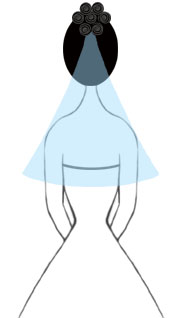 |
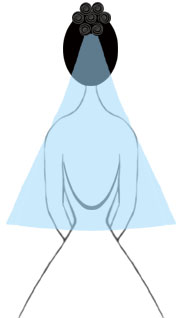 |
Embellishments on the back of your gown? The veil will complement your gown best if it falls 3" above or below any detail work on the back of your gown such as silk flowers or a bow at the waist or the bottom of where a corseted back or a bodice embellished with lace or embroidery ends. Illustrated below.
|
3" above end of corset |
3" below end of corset |
Floor length veils look best when they are either the same length as the train of the gown, or a minimum of 20" beyond the hem or train of the gown.
Length Chart: Please keep in mind that the names of these lengths are approximations and will vary depending on the height of each individual bride. It is the length of your torso, for instance being long or short waisted, which will effect where the veil falls to. Keep in mind that it is the back of your gown that determines the best length to complement your gown.
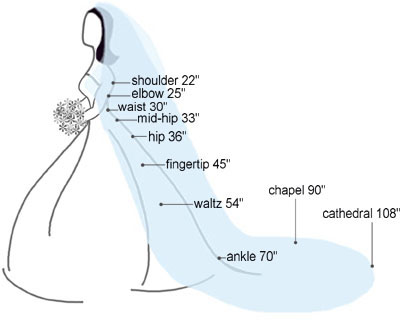
I often have clients ask me about silk tulle veils. While silk tulle sounds elegant and romantic it is actually stiffer then nylon tulle and has a heavier netting look as the individual fibers are spaced further apart then the nylon bridal illusion. Silk tulle should also be finished on the edge as it will fray over time.
Another major factor to consider is a dramatic cost difference. Silk tulle runs $300 a yard. And that is only the cost of the tulle, not any of the labor to cut, sew or edge the veil.
Cost aside my preference has always been for nylon illusion as it has a much more delicate and light appearance.
Veil Worn at Top of the Head
Hair Up: If you are wearing your hair in an updo the veil or headpiece will be most secure if you anchor it on a wire comb directly in front of the updo. Illustrated below.
|
good
veil placement 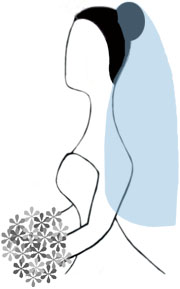 |
less
preferred placement
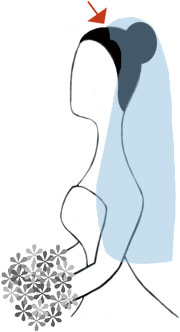 |
Back of the Head
Hair Up: When placing the veil beneath an updo on the back of the head either a small comb or elastic loops are preferable to a regular comb.
The small comb tucks into the hair nicely and can be anchored with one or two bobby pins.
The elastsic loops are pinned into place conforming to the exact shape of the hairstyle.
As seen in the third illustration, the length of a standard comb does not conform to the shape of the headpiece, which leaves an awkward looking gap between the two.
|
|
|
|
Hair Down: When wearing a veil at the top of the head the comb needs something to anchor into. If you are fortunate enough to be working with a professional hairstylist they will know what needs to be done.
If you are on your own, here is a suggestion: Create 2 flat pin curls twisting your own hair into place. From the front slip the comb beneath them as illustrated below.
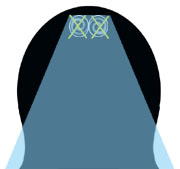
Remember
that accessories are just that. They are meant to accent your bridal
gown, not overpower it. Afer working as a custom - couture accessory
designer in the Greater San Francisco Bay Area for the past 8 years,
I have learned that a clean refined look will always be elegant. Too
many details will look overdone at best and costumish and silly at worst.
Learn more about The Flirty Bride's Rule
of Four accessories.
Please: no reproductions of any type without written consent.
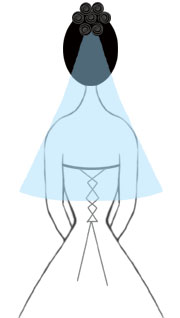
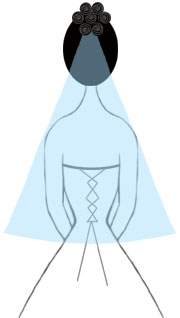
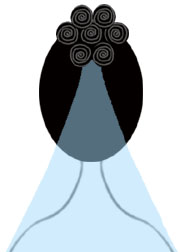 small
comb
small
comb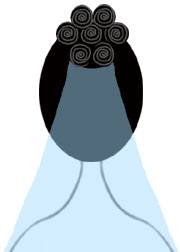 elastic
loops
elastic
loops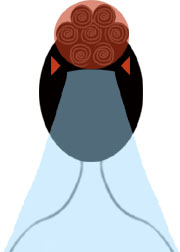 don't
use: regular comb
don't
use: regular comb